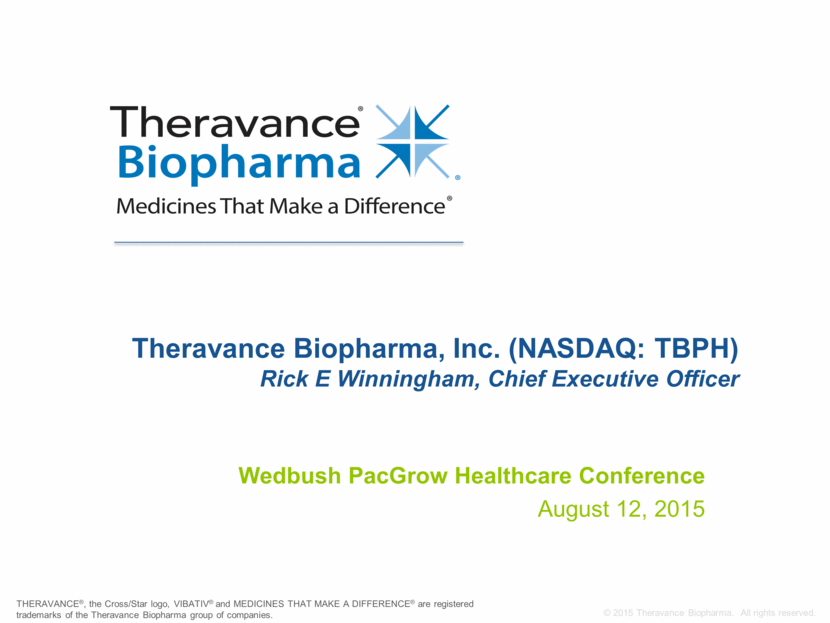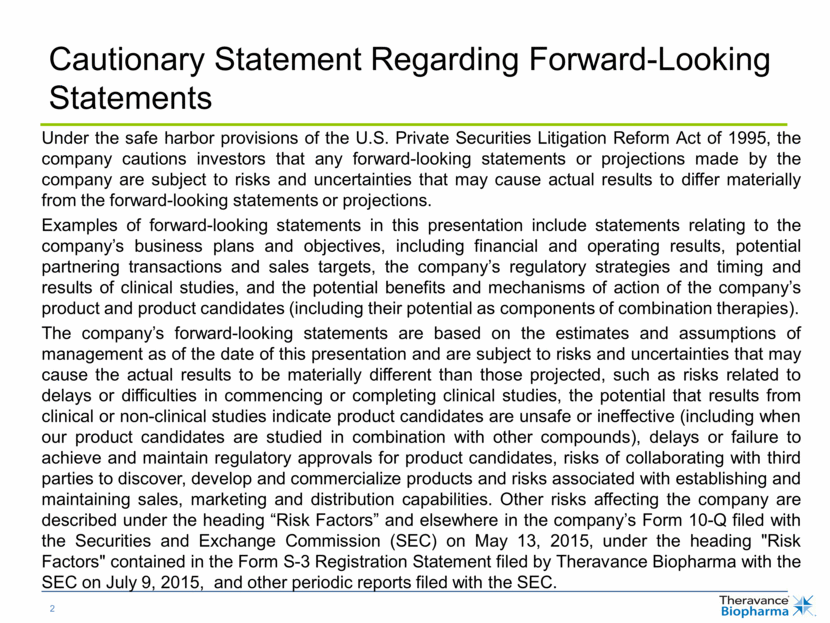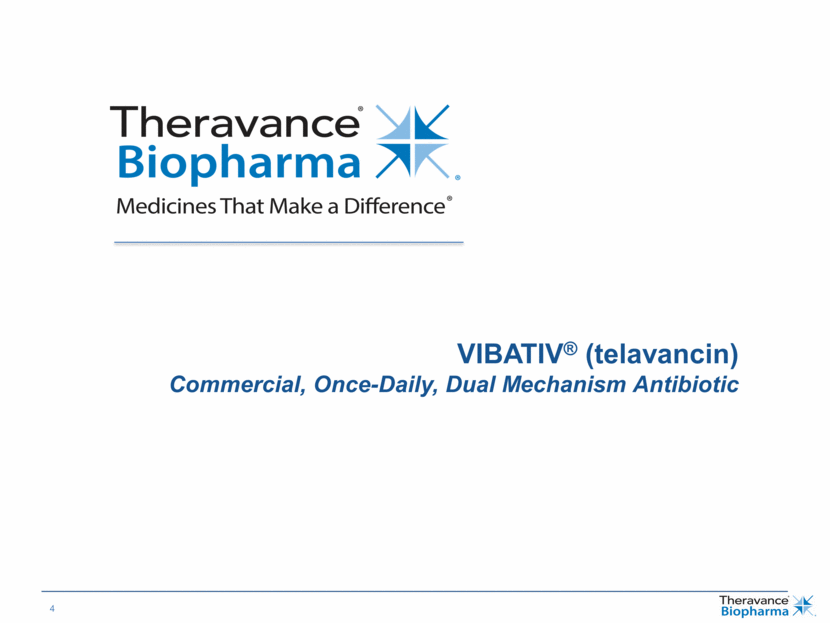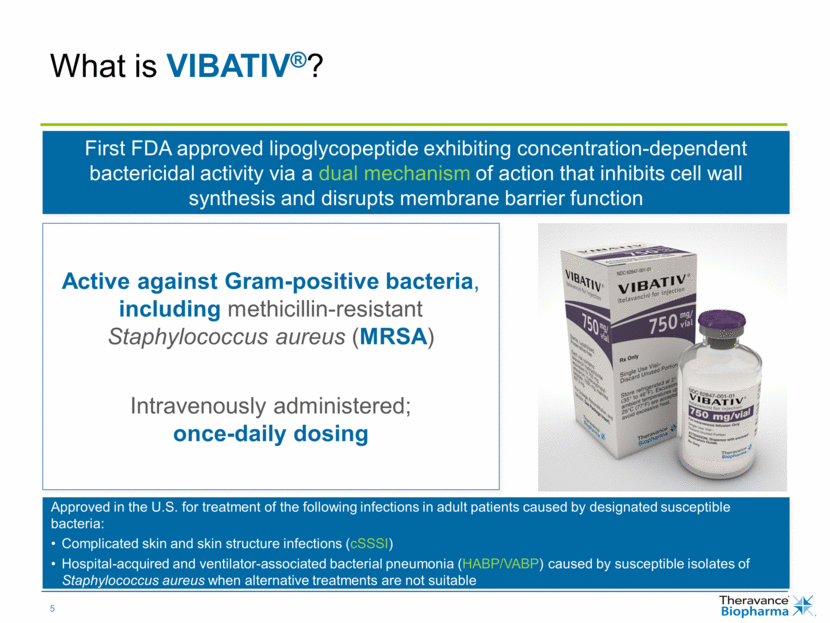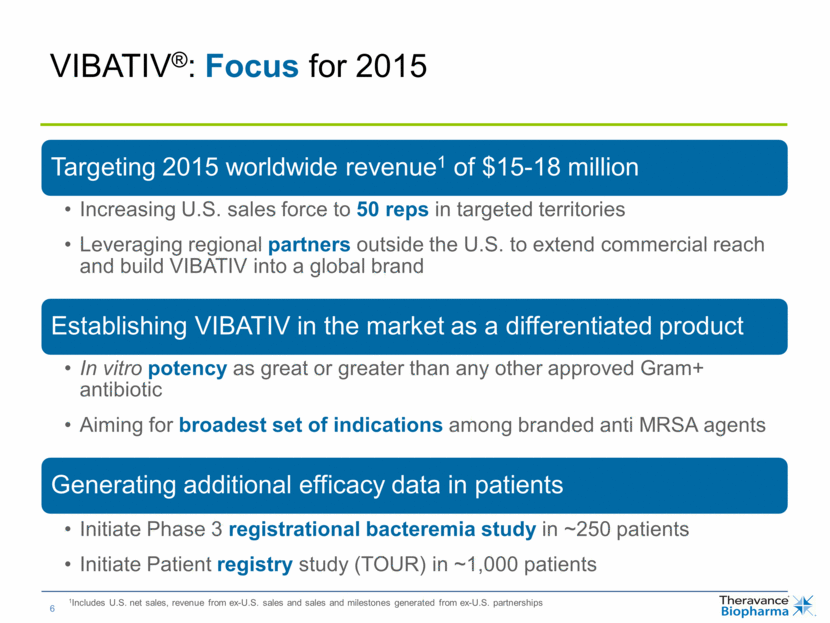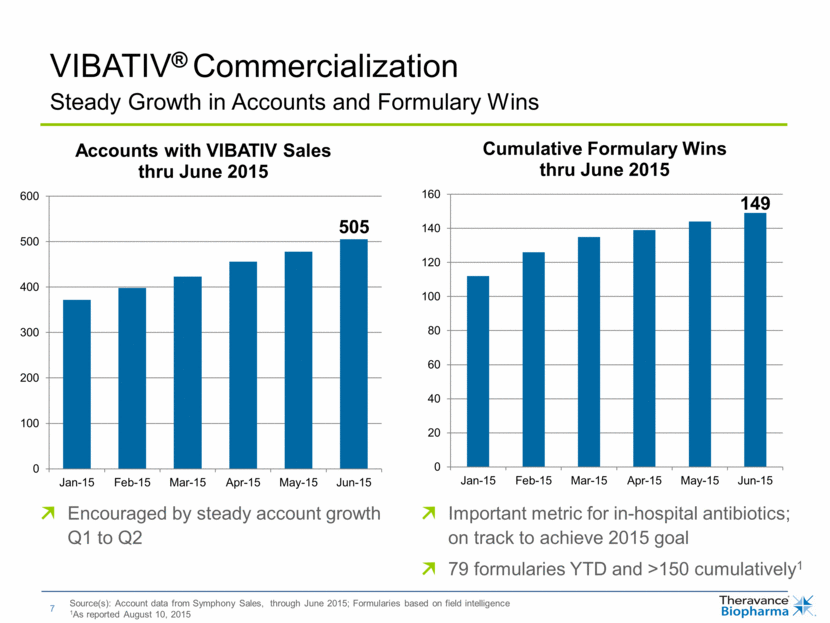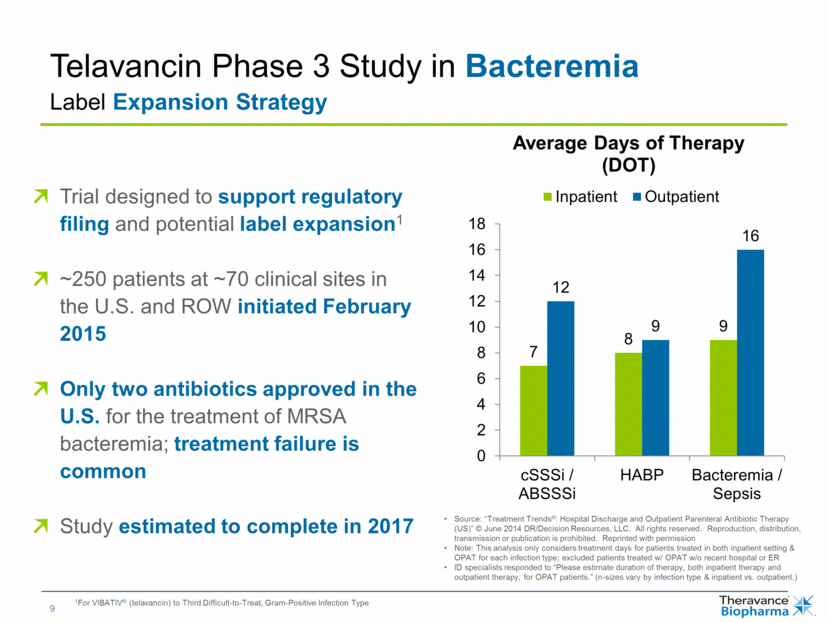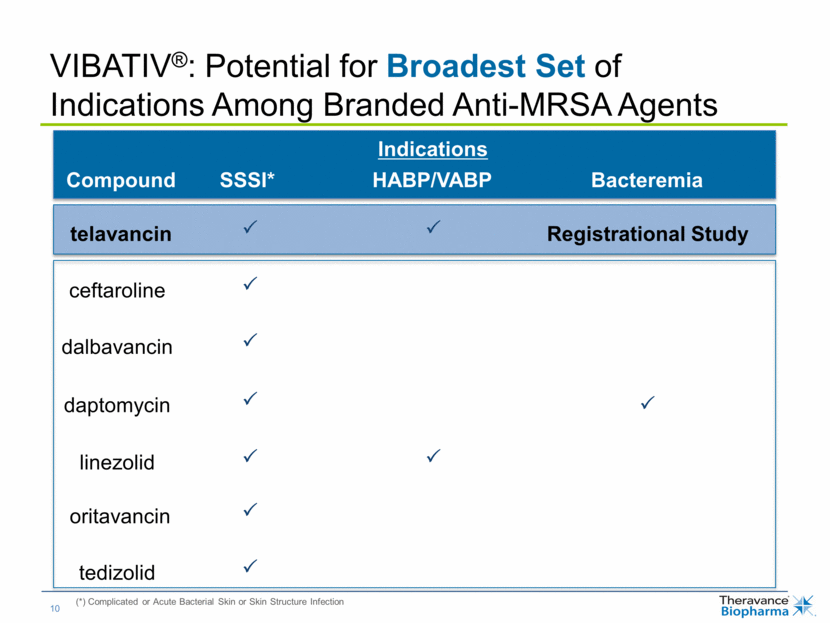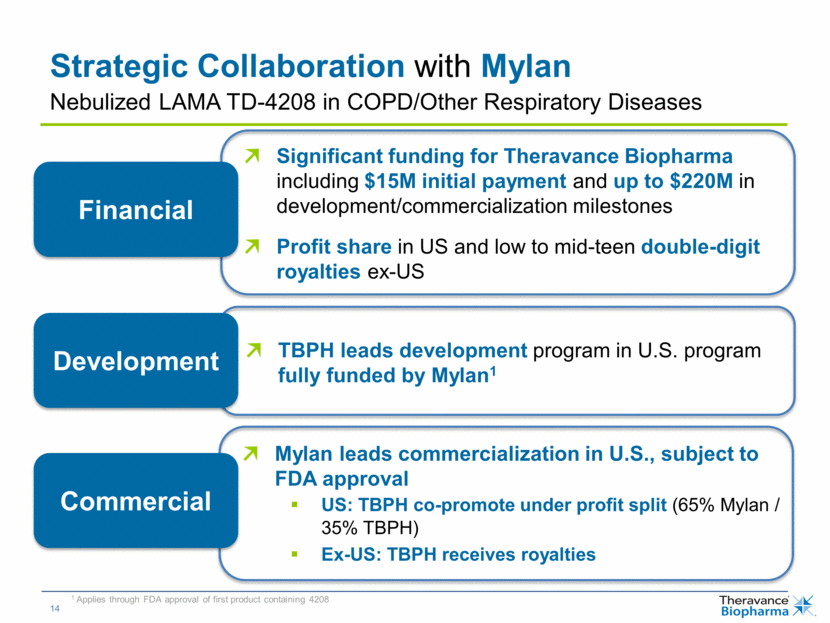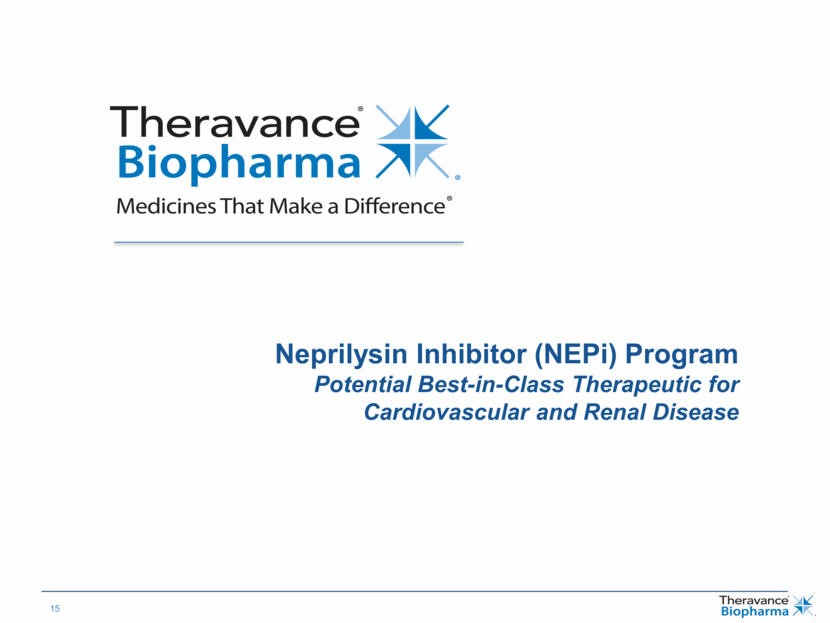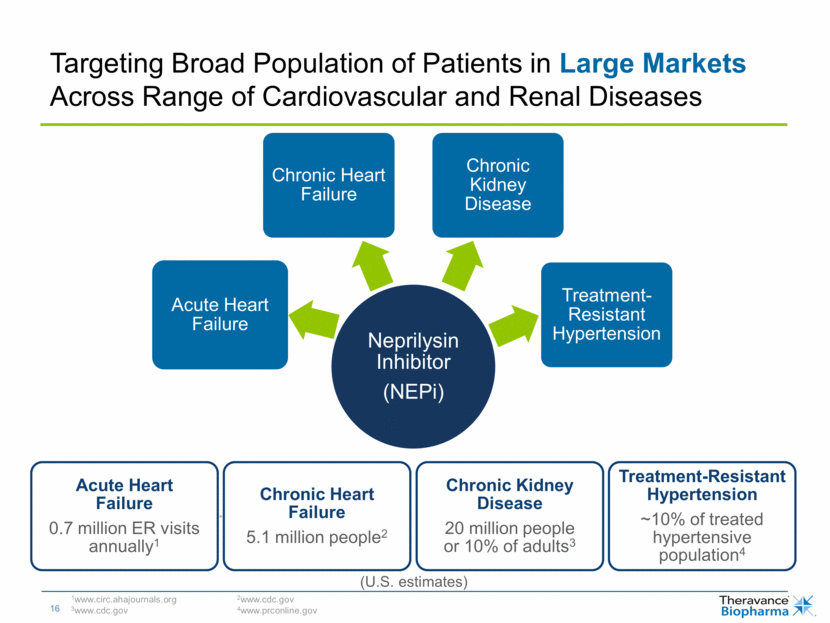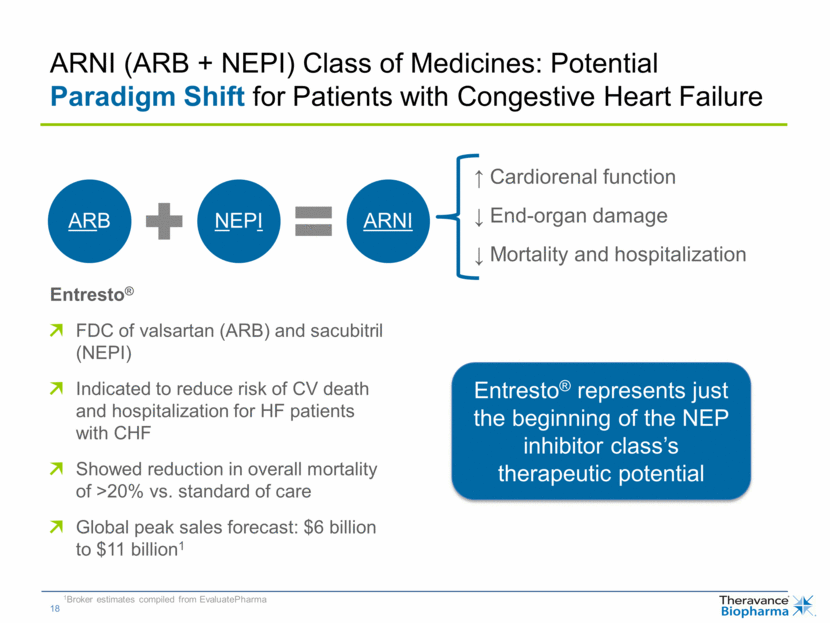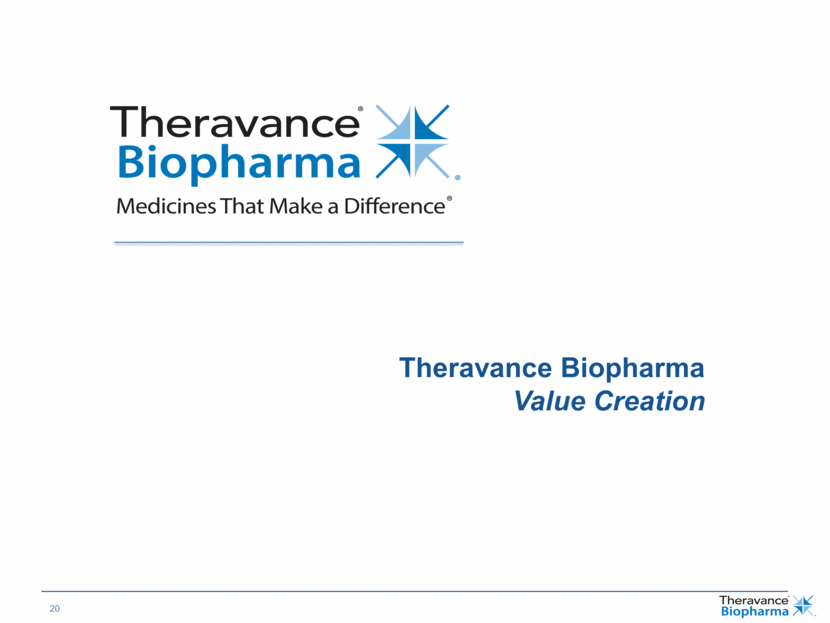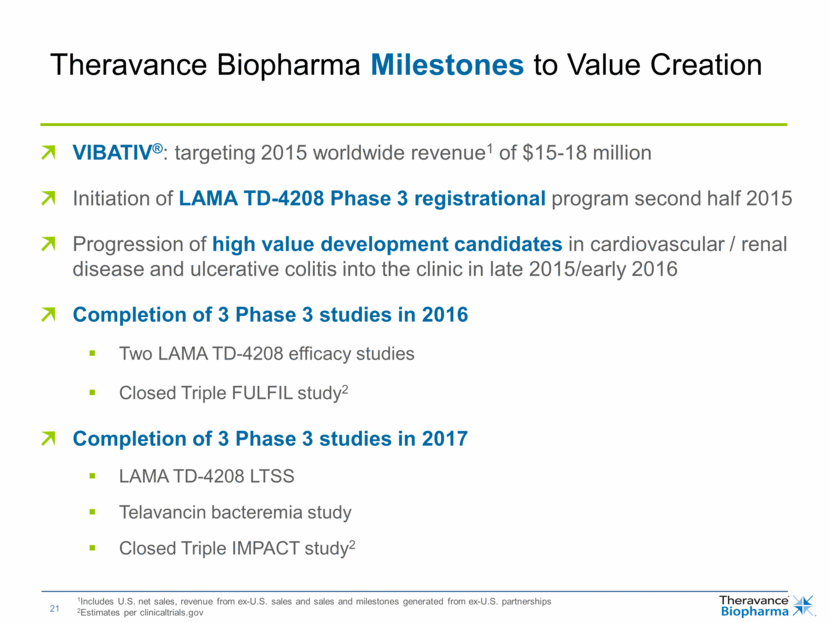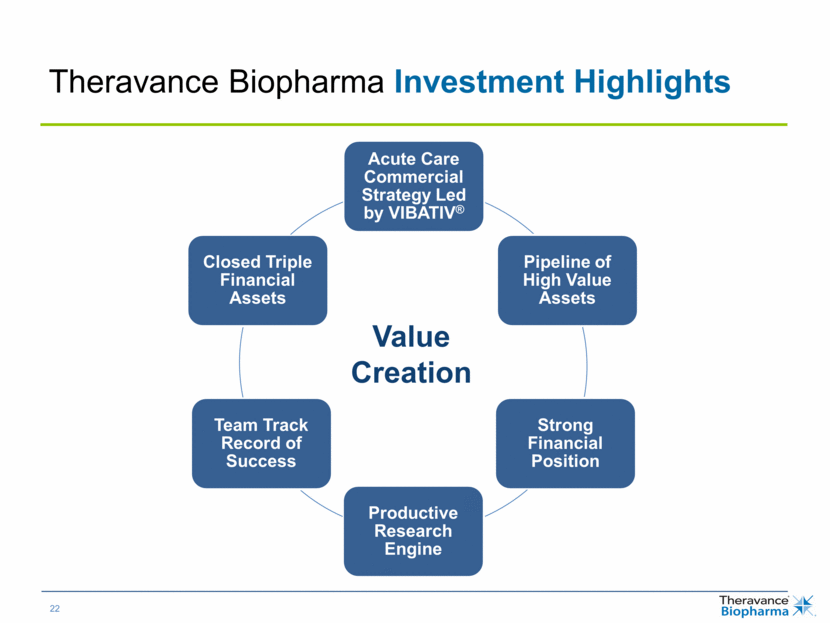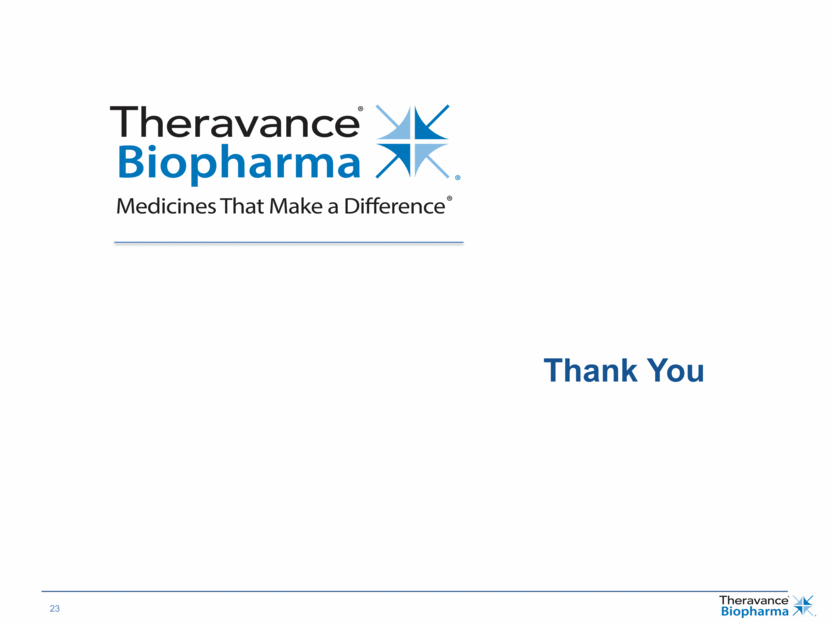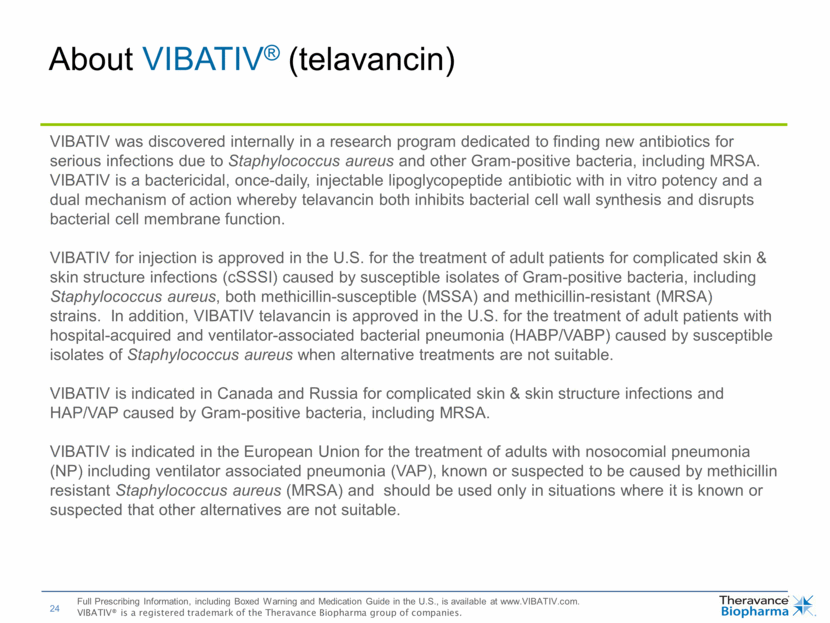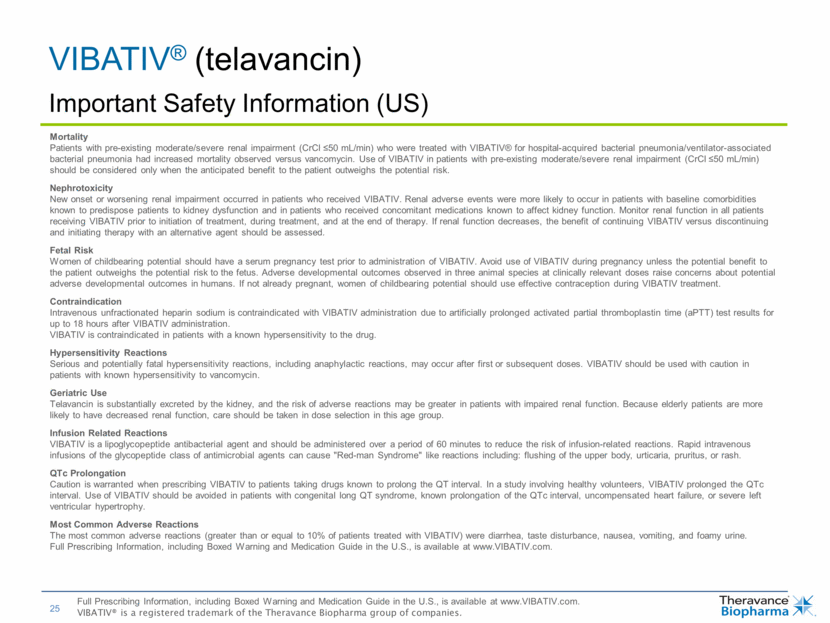Attached files
| file | filename |
|---|---|
| 8-K - 8-K - Theravance Biopharma, Inc. | a15-17515_18k.htm |
Exhibit 99.1
|
|
Wedbush PacGrow Healthcare Conference August 12, 2015 Theravance Biopharma, Inc. (NASDAQ: TBPH) Rick E Winningham, Chief Executive Officer |
|
|
Under the safe harbor provisions of the U.S. Private Securities Litigation Reform Act of 1995, the company cautions investors that any forward-looking statements or projections made by the company are subject to risks and uncertainties that may cause actual results to differ materially from the forward-looking statements or projections. Examples of forward-looking statements in this presentation include statements relating to the company’s business plans and objectives, including financial and operating results, potential partnering transactions and sales targets, the company’s regulatory strategies and timing and results of clinical studies, and the potential benefits and mechanisms of action of the company’s product and product candidates (including their potential as components of combination therapies). The company’s forward-looking statements are based on the estimates and assumptions of management as of the date of this presentation and are subject to risks and uncertainties that may cause the actual results to be materially different than those projected, such as risks related to delays or difficulties in commencing or completing clinical studies, the potential that results from clinical or non-clinical studies indicate product candidates are unsafe or ineffective (including when our product candidates are studied in combination with other compounds), delays or failure to achieve and maintain regulatory approvals for product candidates, risks of collaborating with third parties to discover, develop and commercialize products and risks associated with establishing and maintaining sales, marketing and distribution capabilities. Other risks affecting the company are described under the heading “Risk Factors” and elsewhere in the company’s Form 10-Q filed with the Securities and Exchange Commission (SEC) on May 13, 2015, under the heading "Risk Factors" contained in the Form S-3 Registration Statement filed by Theravance Biopharma with the SEC on July 9, 2015, and other periodic reports filed with the SEC. Cautionary Statement Regarding Forward-Looking Statements |
|
|
Theravance Biopharma Investment Highlights † TBPH is entitled to receive an 85% economic interest in any future payments that may be made by GSK pursuant to its agreements with Theravance, Inc. relating to the Closed Triple program and the MABA program. ‡ Includes cash, cash equivalents and marketable securities as of June 30, 2015 Value Creation $229M Cash‡ Ex-US Tax Domicile Drug Approvals Deal Making Financially Savvy Multiple Strategic Options to Optimize Program Value Economic Interest in Certain GSK Respiratory Assets† Multiple Opportunities for Value Creation Acute Care Commercial Strategy Led by VIBATIV® Pipeline of High Value Assets Strong Financial Position Productive Research Engine Team Track Record of Success Closed Triple Financial Assets |
|
|
VIBATIV® (telavancin) Commercial, Once-Daily, Dual Mechanism Antibiotic |
|
|
What is VIBATIV®? First FDA approved lipoglycopeptide exhibiting concentration-dependent bactericidal activity via a dual mechanism of action that inhibits cell wall synthesis and disrupts membrane barrier function Active against Gram-positive bacteria, including methicillin-resistant Staphylococcus aureus (MRSA) Intravenously administered; once-daily dosing Approved in the U.S. for treatment of the following infections in adult patients caused by designated susceptible bacteria: Complicated skin and skin structure infections (cSSSI) Hospital-acquired and ventilator-associated bacterial pneumonia (HABP/VABP) caused by susceptible isolates of Staphylococcus aureus when alternative treatments are not suitable |
|
|
VIBATIV®: Focus for 2015 1Includes U.S. net sales, revenue from ex-U.S. sales and sales and milestones generated from ex-U.S. partnerships Targeting 2015 worldwide revenue1 of $15-18 million Increasing U.S. sales force to 50 reps in targeted territories Leveraging regional partners outside the U.S. to extend commercial reach and build VIBATIV into a global brand Establishing VIBATIV in the market as a differentiated product In vitro potency as great or greater than any other approved Gram+ antibiotic Aiming for broadest set of indications among branded anti MRSA agents Generating additional efficacy data in patients Initiate Phase 3 registrational bacteremia study in ~250 patients Initiate Patient registry study (TOUR) in ~1,000 patients |
|
|
VIBATIV® Commercialization Source(s): Account data from Symphony Sales, through June 2015; Formularies based on field intelligence 1As reported August 10, 2015 Steady Growth in Accounts and Formulary Wins Important metric for in-hospital antibiotics; on track to achieve 2015 goal 79 formularies YTD and >150 cumulatively1 Encouraged by steady account growth Q1 to Q2 0 100 200 300 400 500 600 Jan-15 Feb-15 Mar-15 Apr-15 May-15 Jun-15 Accounts with VIBATIV Sales thru June 2015 505 149 0 20 40 60 80 100 120 140 160 Jan-15 Feb-15 Mar-15 Apr-15 May-15 Jun-15 Cumulative Formulary Wins thru June 2015 |
|
|
VIBATIV® Commercialization 1Percent change on total mgs sold 2Symphony Sales Data, through June 2015 Clinical data, MSLs and publications driving physician education Physician know-how and experience driving usage Physicians use VIBATIV when3 “other agents fail” “need rapid bactericidal activity” “patients have multiple comorbidities” “cases have documented resistance” Month-to-Month Sales Volume Unit Sales Volume Increased 60% Q1 vs. Q2 20151 Factors Driving Utilization 3TBPH market research 0 500 1,000 1,500 2,000 2,500 Jan-15 Feb-15 Mar-15 Apr-15 May-15 Jun-15 VIBATIV 250mg & 750mg Volume Units 2 VIBATIV 250MG VIBATIV 750MG VIBATIV 250mg Trend VIBATIV 750mg Trend |
|
|
Telavancin Phase 3 Study in Bacteremia Trial designed to support regulatory filing and potential label expansion1 ~250 patients at ~70 clinical sites in the U.S. and ROW initiated February 2015 Only two antibiotics approved in the U.S. for the treatment of MRSA bacteremia; treatment failure is common Study estimated to complete in 2017 Label Expansion Strategy 1For VIBATIV® (telavancin) to Third Difficult-to-Treat, Gram-Positive Infection Type Source: “Treatment Trends®: Hospital Discharge and Outpatient Parenteral Antibiotic Therapy (US)” © June 2014 DR/Decision Resources, LLC. All rights reserved. Reproduction, distribution, transmission or publication is prohibited. Reprinted with permission Note: This analysis only considers treatment days for patients treated in both inpatient setting & OPAT for each infection type; excluded patients treated w/ OPAT w/o recent hospital or ER ID specialists responded to “Please estimate duration of therapy, both inpatient therapy and outpatient therapy, for OPAT patients.” (n-sizes vary by infection type & inpatient vs. outpatient.) 7 8 9 12 9 16 0 2 4 6 8 10 12 14 16 18 cSSSi / ABSSSi HABP Bacteremia / Sepsis Average Days of Therapy (DOT) Inpatient Outpatient |
|
|
VIBATIV®: Potential for Broadest Set of Indications Among Branded Anti-MRSA Agents (*) Complicated or Acute Bacterial Skin or Skin Structure Infection telavancin ceftaroline dalbavancin daptomycin linezolid oritavancin tedizolid Compound Indications SSSI* HABP/VABP Bacteremia Registrational Study |
|
|
TD-4208 Nebulized Long-Acting Muscarinic Antagonist (LAMA) |
|
|
TD-4208: Compelling Need for Once-Daily Nebulized LAMA 1 Global Strategy for Diagnosis, Management, and Prevention of COPD 2 TBPH market research (N = 160 physicians); Refers to US COPD patients 3Estimate derived from use of information under license from the following IMS Health information service: NSP for period MAT May, 2015. Excludes nebulized short-acting beta agonists. IMS expressly reserves all rights, including rights of copying, distribution and republication Enduring Patient Niche and Significant Market Opportunity Unmet Need for Nebulized LAMA Therapy Once-daily LAMAs are first-line therapy for moderate to severe COPD1 No nebulized LAMAs available today; only available in handhelds Enduring Patient Niche with Potential for Premium Pricing >100M patient treatment days in nebulized LABA, SAMA and SAMA/SABA therapy3 41% of COPD patients use nebulizers at least occasionally for bronchodilator therapy2 9% of COPD patients currently use nebulizers for ongoing maintenance therapy2 Pricing in branded LA nebulized segment ~ 2x premium to handheld Spiriva3 Significant Market Opportunity TD-4208 complementary to existing nebulized LABA treatment options Mylan brings commercial strength in nebulized segment |
|
|
Favorable Phase 2 Results Support Phase 3 Registrational Program in COPD 355 patients with moderate to severe COPD Primary endpoint: Change from baseline in trough FEV1 following 28 days Note: FEV1 = forced expiratory volume in one second TD-4208 (mcg) p-values versus placebo: <0.001*** Phase 2b Study 0117 Met Primary Endpoint at 88 mcg and Above Two replicate 3-month efficacy studies expected to read-out in 2016 Single 12-month safety study expected to read-out in 2017 ~2,300 patients across three studies Studies will test two doses: 88 mcg and 175 mcg administered once-daily Plan to Initiate Phase 3 Program in second half of 2015 |
|
|
Strategic Collaboration with Mylan Significant funding for Theravance Biopharma including $15M initial payment and up to $220M in development/commercialization milestones Profit share in US and low to mid-teen double-digit royalties ex-US TBPH leads development program in U.S. program fully funded by Mylan1 Mylan leads commercialization in U.S., subject to FDA approval US: TBPH co-promote under profit split (65% Mylan / 35% TBPH) Ex-US: TBPH receives royalties Financial Development Commercial 1 Applies through FDA approval of first product containing 4208 Nebulized LAMA TD-4208 in COPD/Other Respiratory Diseases |
|
|
Neprilysin Inhibitor (NEPi) Program Potential Best-in-Class Therapeutic for Cardiovascular and Renal Disease |
|
|
Targeting Broad Population of Patients in Large Markets Across Range of Cardiovascular and Renal Diseases 1www.circ.ahajournals.org 2www.cdc.gov 3www.cdc.gov 4www.prconline.gov (U.S. estimates) Neprilysin Inhibitor (NEPi) Acute Heart Failure Chronic Heart Failure Chronic Kidney Disease Treatment- Resistant Hypertension Treatment-Resistant Hypertension ~10% of treated hypertensive population4 Chronic Heart Failure 5.1 million people2 Acute Heart Failure 0.7 million ER visits annually1 Chronic Kidney Disease 20 million people or 10% of adults3 |
|
|
NEP: Key Therapeutic Target for Cardiovascular and Renal Diseases Degradation of natriuretic peptides Reduction in mortality and morbidity in CHF patients Diuresis Control of blood pressure Reversal of maladaptive changes in heart and vascular tissue Utility of NEP in Cardiovascular and Renal Disease |
|
|
ARNI (ARB + NEPI) Class of Medicines: Potential Paradigm Shift for Patients with Congestive Heart Failure Cardiorenal function End-organ damage Mortality and hospitalization Entresto® FDC of valsartan (ARB) and sacubitril (NEPI) Indicated to reduce risk of CV death and hospitalization for HF patients with CHF Showed reduction in overall mortality of >20% vs. standard of care Global peak sales forecast: $6 billion to $11 billion1 Entresto® represents just the beginning of the NEP inhibitor class’s therapeutic potential 1Broker estimates compiled from EvaluatePharma ARB NEPI ARNI |
|
|
NEPi Program: Versatile Platform Across Wide Spectrum of Treatments Disease Indications Clinical Validation1 Preclinical Validation2 Chronic Heart Failure Acute Heart Failure Hypertension Chronic Kidney Disease ARB Combination (ARNI) Optimized for CHF and/or CKD 1 Using LCZ696/omapatrilat 2 Using candoxatril/omapatrilat IV NEPi: AHF Monotherapy NEPi Range of Cardiorenal Indications Non-ARB Combinations (e.g. PDE5, PDE9, sGC, MRA) TBPH NEPi Key Potential Points of Differentiation Non-renally cleared Potential once-daily dosing Oral and IV administration Mono- or combo-therapy (FDC or co-administration) Program Goals Target broad populations of patients with cardiovascular and renal disease Multiple candidates progressing through pre-IND tox; initiate Phase 1 late 2015/early 2016 Key value inflection Phase 1b/2a |
|
|
Theravance Biopharma Value Creation |
|
|
VIBATIV®: targeting 2015 worldwide revenue1 of $15-18 million Initiation of LAMA TD-4208 Phase 3 registrational program second half 2015 Progression of high value development candidates in cardiovascular / renal disease and ulcerative colitis into the clinic in late 2015/early 2016 Completion of 3 Phase 3 studies in 2016 Two LAMA TD-4208 efficacy studies Closed Triple FULFIL study2 Completion of 3 Phase 3 studies in 2017 LAMA TD-4208 LTSS Telavancin bacteremia study Closed Triple IMPACT study2 1Includes U.S. net sales, revenue from ex-U.S. sales and sales and milestones generated from ex-U.S. partnerships 2Estimates per clinicaltrials.gov Theravance Biopharma Milestones to Value Creation |
|
|
Theravance Biopharma Investment Highlights Value Creation Acute Care Commercial Strategy Led by VIBATIV® Pipeline of High Value Assets Strong Financial Position Productive Research Engine Team Track Record of Success Closed Triple Financial Assets |
|
|
Thank You |
|
|
About VIBATIV® (telavancin) VIBATIV was discovered internally in a research program dedicated to finding new antibiotics for serious infections due to Staphylococcus aureus and other Gram-positive bacteria, including MRSA. VIBATIV is a bactericidal, once-daily, injectable lipoglycopeptide antibiotic with in vitro potency and a dual mechanism of action whereby telavancin both inhibits bacterial cell wall synthesis and disrupts bacterial cell membrane function. VIBATIV for injection is approved in the U.S. for the treatment of adult patients for complicated skin & skin structure infections (cSSSI) caused by susceptible isolates of Gram-positive bacteria, including Staphylococcus aureus, both methicillin-susceptible (MSSA) and methicillin-resistant (MRSA) strains. In addition, VIBATIV telavancin is approved in the U.S. for the treatment of adult patients with hospital-acquired and ventilator-associated bacterial pneumonia (HABP/VABP) caused by susceptible isolates of Staphylococcus aureus when alternative treatments are not suitable. VIBATIV is indicated in Canada and Russia for complicated skin & skin structure infections and HAP/VAP caused by Gram-positive bacteria, including MRSA. VIBATIV is indicated in the European Union for the treatment of adults with nosocomial pneumonia (NP) including ventilator associated pneumonia (VAP), known or suspected to be caused by methicillin resistant Staphylococcus aureus (MRSA) and should be used only in situations where it is known or suspected that other alternatives are not suitable. Full Prescribing Information, including Boxed Warning and Medication Guide in the U.S., is available at www.VIBATIV.com. VIBATIV® is a registered trademark of the Theravance Biopharma group of companies. |
|
|
VIBATIV® (telavancin) Important Safety Information (US) Mortality Patients with pre-existing moderate/severe renal impairment (CrCl <50 mL/min) who were treated with VIBATIV® for hospital-acquired bacterial pneumonia/ventilator-associated bacterial pneumonia had increased mortality observed versus vancomycin. Use of VIBATIV in patients with pre-existing moderate/severe renal impairment (CrCl <50 mL/min) should be considered only when the anticipated benefit to the patient outweighs the potential risk. Nephrotoxicity New onset or worsening renal impairment occurred in patients who received VIBATIV. Renal adverse events were more likely to occur in patients with baseline comorbidities known to predispose patients to kidney dysfunction and in patients who received concomitant medications known to affect kidney function. Monitor renal function in all patients receiving VIBATIV prior to initiation of treatment, during treatment, and at the end of therapy. If renal function decreases, the benefit of continuing VIBATIV versus discontinuing and initiating therapy with an alternative agent should be assessed. Fetal Risk Women of childbearing potential should have a serum pregnancy test prior to administration of VIBATIV. Avoid use of VIBATIV during pregnancy unless the potential benefit to the patient outweighs the potential risk to the fetus. Adverse developmental outcomes observed in three animal species at clinically relevant doses raise concerns about potential adverse developmental outcomes in humans. If not already pregnant, women of childbearing potential should use effective contraception during VIBATIV treatment. Contraindication Intravenous unfractionated heparin sodium is contraindicated with VIBATIV administration due to artificially prolonged activated partial thromboplastin time (aPTT) test results for up to 18 hours after VIBATIV administration. VIBATIV is contraindicated in patients with a known hypersensitivity to the drug. Hypersensitivity Reactions Serious and potentially fatal hypersensitivity reactions, including anaphylactic reactions, may occur after first or subsequent doses. VIBATIV should be used with caution in patients with known hypersensitivity to vancomycin. Geriatric Use Telavancin is substantially excreted by the kidney, and the risk of adverse reactions may be greater in patients with impaired renal function. Because elderly patients are more likely to have decreased renal function, care should be taken in dose selection in this age group. Infusion Related Reactions VIBATIV is a lipoglycopeptide antibacterial agent and should be administered over a period of 60 minutes to reduce the risk of infusion-related reactions. Rapid intravenous infusions of the glycopeptide class of antimicrobial agents can cause "Red-man Syndrome" like reactions including: flushing of the upper body, urticaria, pruritus, or rash. QTc Prolongation Caution is warranted when prescribing VIBATIV to patients taking drugs known to prolong the QT interval. In a study involving healthy volunteers, VIBATIV prolonged the QTc interval. Use of VIBATIV should be avoided in patients with congenital long QT syndrome, known prolongation of the QTc interval, uncompensated heart failure, or severe left ventricular hypertrophy. Most Common Adverse Reactions The most common adverse reactions (greater than or equal to 10% of patients treated with VIBATIV) were diarrhea, taste disturbance, nausea, vomiting, and foamy urine. Full Prescribing Information, including Boxed Warning and Medication Guide in the U.S., is available at www.VIBATIV.com. Full Prescribing Information, including Boxed Warning and Medication Guide in the U.S., is available at www.VIBATIV.com. VIBATIV® is a registered trademark of the Theravance Biopharma group of companies. |
|
|
Q&A Session |

